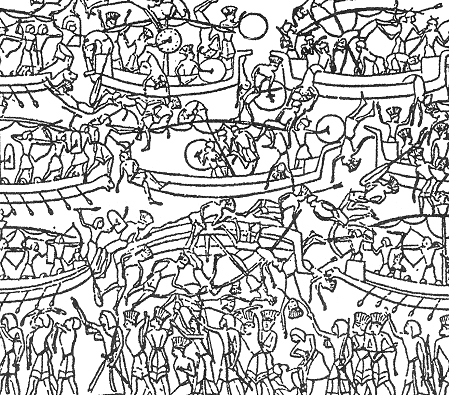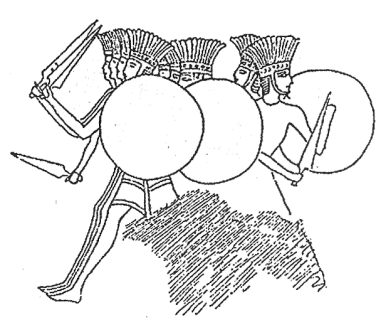Considering the horizon of the Italian peninsula and great islands, the currently prevailing archaeological theories limit the “external” cultural influences after the final Bronze Age (the so called “proto-Villanovan”: 1200-900 B.C.) to the Greek colonization of Southern Italy (775 B.C.) or to the contemporary Punic-Phoenician colonization of Sardinia and part of Sicily. Investigating if the Etruscan phenomenon was due to external ethnic contributions or to inner cultural transformations, the current theory inclines for “the inner” solution, considering the Etruscan civilization to be an evolution of the “Villanovan” one, as a result of economic exchanges with the Greeks and the Punic-Phoenician.
However, the analysis of the Eastern Mediterranean vicissitudes occurring coeval or immediately after the “Mycenaean collapse” (1200 B.C.) and the “stasis” of the Greek expansion in the whole Mediterranean until to ca. 775 B.C. (the so called “Greek Middle Ages”) induces us to assume the existence of significant contributions also by Aegean-Anatolian populations, traditionally known as the “Sea Populations”, who settled down in the Syrian-Palestinian corridor during the final Bronze Age.
Still now, the proper names of these populations have not been recognized with certainty. They are generically identified as “Sea Populations, from the North and Islands” in the hieroglyphic inscriptions from the Egyptian Temple of Medinhet Habu (12th century B.C.), where they are represented as foreign invading armies followed by women, children and furnishings that have been defeated in battle by the Pharaoh. Other coeval documents mention the fact, too.
Depictions show the so called Shardana population with horned headgear, defensive corsage, and long sword handle as a crescent. The Pheleset are portrayed with plumed hat; some coeval representations from Enkomi (Cyprus) propose the same type of headgear. The Sheklesh, instead, wore a sort of bonnet tied at the nape.

Sheklesh, Pheleset and Shardana are mentioned as “Northern Populations”. Tyrsh (and Shardana again) are cited as “Sea Populations (from the coast)” and/or “from the Islands”. The English archaeologist James Mellaart, specialized in the Asia Minor civilizations, assumed that Sheklesh and Pheleset were populations from Pamphylia (the coast of the present south-western Turkey).
A survey on the features of the army of such populations induces us to define them consistent to those of the Greek-Mycenaean army, as described in the Homeric poems. Indeed, they appear expression of independent communities based on personal commitment, with their territory (from which they would emigrate due to famines and pressure of invading populations), with a complex ethnic structure and hierarchy.
The above-mentioned features seem to indicate that the Sea Populations, definitely coming from the Aegean-Anatolian area (partially from Crete, too), were composed of various groups which were culturally connected with the Greek-Mycenaean Commonwealth (Mycenaeans plus colonizers from Anatolia and the Islands, plus allied from other Anatolian ethnic groups).
Climatic and cultural data would confirm that, around the second half of 13th century B.C., an economic collapse involved the Aegean-Anatolian area. It was the great famine reported in Egyptians and Ugaritic documents. The situation was made worst by attacks to the coasts from Balkan populations (Dorians? Phrygians). The reaction to the emergency would be massive emigrations towards territories with more favourable living conditions (Egypt, Palestine, Italy), violently impacting with the aboriginal people. In a short time, the settlements approximately diminished of 50% in the Greek peninsula.
A consistent archaeological indication of the spread of these populations in the Mediterranean basin could be the discovery of Mycenean III C type ceramics in the Syrian-Palestinian area or in Italy, in particular when the neutronic analysis reveals that it is not imported but produced in situ. Such a type of ceramics is attributed by the archaeologists to the Sea Populations.
The spread of the previous style of such ceramics (III B) in the Near East demonstrates that groups connected to the Mycenaeans already lived there in the 13th century B.C., even if in small numbers. However, all the archaeological excavations document that this style suddenly disappeared about 1200 B.C. in levels revealing a violent destruction. Everywhere, later on, the subsequent Mycenaean III C 1 b ceramics appears (monochrome ceramic plates 1175-1125 B.C.).




